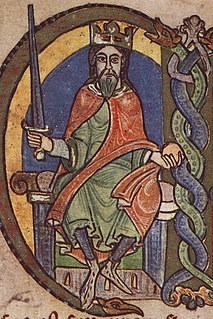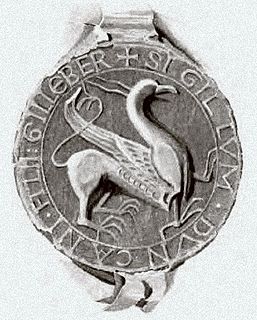Related Research Articles

David I or Dauíd mac Maíl Choluim was a 12th-century ruler who was Prince of the Cumbrians from 1113 to 1124 and later King of Scotland from 1124 to 1153. The youngest son of Malcolm III and Margaret of Wessex, David spent most of his childhood in Scotland, but was exiled to England temporarily in 1093. Perhaps after 1100, he became a dependent at the court of King Henry I. There he was influenced by the Anglo-French culture of the court.

Donnchadh was a Gall-Gaidhil prince and Scottish magnate in what is now south-western Scotland, whose career stretched from the last quarter of the 12th century until his death in 1250. His father, Gille-Brighde of Galloway, and his uncle, Uhtred of Galloway, were the two rival sons of Fergus, Prince or Lord of Galloway. As a result of Gille-Brighde's conflict with Uhtred and the Scottish monarch William the Lion, Donnchadh became a hostage of King Henry II of England. He probably remained in England for almost a decade before returning north on the death of his father. Although denied succession to all the lands of Galloway, he was granted lordship over Carrick in the north.

The Kingdom of Alba was the Kingdom of Scotland between the deaths of Donald II in 900 and of Alexander III in 1286. The second led indirectly to an invasion of Scotland by Edward I of England in 1296 and the First War of Scottish Independence.
Scottish legal institutions in the High Middle Ages are, for the purposes of this article, the informal and formal systems which governed and helped to manage Scottish society between the years 900 and 1288, a period roughly corresponding with the general European era usually called the High Middle Ages. Scottish society in this period was predominantly Gaelic. Early Gaelic law tracts, first written down in the ninth century reveal a society highly concerned with kinship, status, honour and the regulation of blood feuds. The early Scottish lawman, or Breitheamh, became the Latin Judex; the great Breitheamh became the magnus Judex, which arguably developed into the office of Justiciar, an office which survives to this day in that of Lord Justice General. Scottish common law began to take shape at the end of the period, assimilating Gaelic and Celtic law with practices from Anglo-Norman England and the Continent.

The High Middle Ages of Scotland encompass Scotland in the era between the death of Domnall II in 900 AD and the death of King Alexander III in 1286, which was an indirect cause of the Wars of Scottish Independence.
The Justiciar of Scotia was the most senior legal office in the High Medieval Kingdom of Scotland. Scotia in this context refers to Scotland to the north of the River Forth and River Clyde. The other Justiciar positions were the Justiciar of Lothian and the Justiciar of Galloway.
The Justiciar of Lothian was an important legal office in the High Medieval Kingdom of Scotland.
Jocelin was a twelfth-century Cistercian monk and cleric who became the fourth Abbot of Melrose before becoming Bishop of Glasgow, Scotland. He was probably born in the 1130s, and in his teenage years became a monk of Melrose Abbey. He rose in the service of Abbot Waltheof, and by the time of the short abbacy of Waltheof's successor Abbot William, Jocelin had become prior. Then in 1170 Jocelin himself became abbot, a position he held for four years. Jocelin was responsible for promoting the cult of the emerging Saint Waltheof, and in this had the support of Enguerrand, Bishop of Glasgow.
Walter FitzAlan was a twelfth-century English baron who became a Scottish magnate and Steward of Scotland. He was a younger son of Alan fitz Flaad and Avelina de Hesdin. In about 1136, Walter entered into the service of David I, King of Scotland. He became the king's dapifer or steward in about 1150, and served as such for three successive Scottish kings: David, Malcolm IV and William I. In time, the stewardship became hereditarily held by Walter's descendants.
Hugh de Morville of Appleby in Westmorland, England, hereditary Constable of Scotland, was a Norman knight who made his fortune in the service of David FitzMalcolm (d.1153), Prince of the Cumbrians, later King of Scotland.
Patrick II (1185–1249), called "6th Earl of Dunbar", was a 13th-century Anglo-Scottish noble, and one of the leading figures during the reign of King Alexander II of Scotland.

Before David I became the king of Scotland in 1124, he was the prince of the Cumbrians and earl of a great territory in the middle of England acquired by marriage. This period marks the beginning of his life as a great territorial lord. Circa 1113, the year in which King Henry I of England arranged his marriage to an English heiress and the year in which for the first time David can be found in possession of "Scottish" territory, marks the beginning of his rise to Scottish leadership.

Political and military events in Scotland during the reign of David I are the events which took place in Scotland during David I of Scotland's reign as King of Scots, from 1124 to 1153. When his brother Alexander I of Scotland died in 1124, David chose, with the backing of Henry I of England, to take the Kingdom of Alba for himself. David was forced to engage in warfare against his rival and nephew, Máel Coluim mac Alaxandair. Subduing the latter took David ten years, and involved the destruction of Óengus, mormaer of Moray. David's victory allowed him to expand his control over more distant regions theoretically part of the Kingdom. In this he was largely successful, although he failed to bring the Earldom of Orkney into his kingdom.

The relationship between the Kingdom of England and King David I, who was King of Scotland between 1124 and 1153, was partly shaped by David's relationship with the particular King of England, and partly by David's own ambition. David had a good relationship with and was an ally of Henry I of England, the King who was largely responsible for David's early career. After Henry's death, David upheld his support for his niece, the former Empress-consort, Matilda, and expanded his power in northern England in the process, despite his defeat at the Battle of the Standard in 1138.

The Davidian Revolution is a name given by many scholars to the changes which took place in the Kingdom of Scotland during the reign of David I (1124–1153). These included his foundation of burghs, implementation of the ideals of Gregorian Reform, foundation of monasteries, Normanisation of the Scottish government, and the introduction of feudalism through immigrant Norman and Anglo-Norman knights.

David de Lindsay, Lord of Barnweill and Byres, was a Scottish knight and crusader. A minor baronial lord, he was the son of David de Lindsay and held lands in East Lothian and South Ayrshire. He became Justiciar of Lothian under Alexander II of Scotland in 1241. This position had been held by his father earlier in the century.
Sir David de Lindsay, Lord of Crawford and Ercildum, known as "the elder" to distinguish him from his son, was an Anglo-Scottish baron of the 12th and 13th century.
Thor of Tranent, also known as Thor, son of Sveinn or Thor, son of Swain, Lord of Tranent and Sheriff of Lothian, was a landlord and chieftain active in Lothian in the reign of King David I of Scotland. He is attested in a large number of charters during King David's reign in Lothian, both as a charter witness on charters granted by other patrons and on charters he himself issued. His name appears either as Thor son of Sveinn or "Thor of Tranent", the latter appellation deriving from his ownership of the "barony" of Tranent, East Lothian, lands including a wide area around the modern town, including, for instance, Prestonpans.
Gervase Avenel, Lord of Eskdale and Abercorn was a 12th-13th century noble. He served as Justiciar in Lothian between 1206 until 1215 and served as Constable of Roxburgh Castle. He was a son of Robert Avenel and Sybil. Gervase was buried in the Chapter House of Melrose Abbey.
The Galloway revolt of 1234–1235 was an uprising in Galloway during 1234–1235, led by Tomás mac Ailein and Gille Ruadh. The uprising was in response to the succession of Alan of Galloway, whereby King Alexander II of Scotland ordered Galloway to be divided the amongst Alan's three heiresses under Norman feudal law. This judgement excluded Alan's illegitimate son Tomás, who believed he was the rightful heir under the Gaelic system of tanistry. Alexander II responded by leading an army into Galloway to crush the rebellion. The Scottish army was almost routed, however was saved by the arrival of Fearchar, Earl of Ross and his forces. Walter Comyn, Lord of Badenoch was left to mop up the revolt, however was forced to abandon the region. Patrick II, Earl of Dunbar led another army in 1235, with Adam, Abbot of Melrose, and Gilbert, Bishop of Galloway and forced the submission of Tomás and Gille.
References
- Anderson, Alan Orr, ed. (1922), Early Sources of Scottish History A.D. 500 to 1286 (2 vols), Edinburgh: Oliver and Boyd
- Barrow, G. W. S., ed. (1971), The Acts of William I : King of Scots, 1165–1214 , Regesta Regum Scottorum, vol. ii, Edinburgh: Edinburgh University Press, ISBN 0-85224-142-9
- Barrow, G. W. S. (2003), The Kingdom of the Scots: Government, Church and Society from the Eleventh to the Fourteenth Century (2nd ed.), Edinburgh: Edinburgh University Press, ISBN 0-7486-1802-3
- McAndrew, Bruce A. (2006), Scotland's Historic Heraldry, Woodbridge: The Boydell Press, ISBN 1-84383-261-5
- Taylor, Alice (2008), "Robert de Londres, Illegitimate Son of William, King of Scots", The Haskins Society Journal: Studies in Medieval History, London: Hambledon Press, 19: 99–119, ISSN 0963-4959